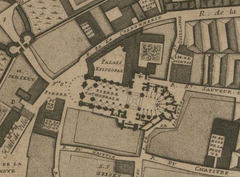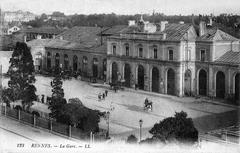
City Walls of Rennes: Visiting Hours, Tickets, and Historical Sites Guide
Date: 04/07/2025
Introduction
Nestled in the heart of Brittany, the City Walls of Rennes—known as “les remparts de Rennes”—offer a fascinating journey through over two millennia of history, culture, and architecture. Originating as Roman fortifications in the 3rd century and evolving through the Middle Ages, these walls once encircled the city’s historic core, serving as formidable defenses and powerful symbols of regional identity. The most iconic surviving structure, the Portes Mordelaises, stands as a ceremonial gateway that witnessed the investiture of Breton dukes and remains a testament to Rennes’ political and cultural significance within the Duchy of Brittany. Today, these remnants are thoughtfully integrated into the modern cityscape, inviting visitors to explore their storied past while enjoying scenic promenades and lively cultural events. This comprehensive guide provides essential information on visiting hours, ticketing, guided tours, accessibility, and travel tips to help you make the most of your visit to Rennes’ ancient ramparts (Rennes Tourist Office; France-Voyage; Voyage Tips).
Table of Contents
- Introduction
- Historical Evolution and Significance
- Medieval Fortifications: Structure and Layout
- Surviving Remnants and Restoration
- Integration with the Urban Landscape
- Visitor Information
- Nearby Attractions and Events
- Visuals and Media
- Frequently Asked Questions (FAQ)
- Summary and Recommendations
- References
Historical Evolution and Significance
Origins and Development
The city walls of Rennes date back over 2,000 years, with the earliest fortifications constructed during the Roman period to protect the settlement of Condate at the confluence of the Ille and Vilaine rivers (Wikipedia). As Rennes grew in importance within the Duchy of Brittany, the ramparts were repeatedly reinforced and expanded, especially between the 3rd and 15th centuries. These fortifications served both defensive and symbolic roles, protecting the city from invasions and demarcating its boundaries (Forbes).
The most prominent surviving section is the Portes Mordelaises, which became the principal entrance to the city from the 15th century onwards. All Dukes of Brittany were required to pass through and swear an oath beneath its arch before their induction, earning it the nickname “royal door” (Voyage Tips).
As the city modernized, large portions of the walls were dismantled, especially after the destructive fire of 1720, but key elements like the Mordelaises Gates remain as enduring symbols of Rennes’ identity (Wikipedia).
Medieval Fortifications: Structure and Layout
Ramparts and Towers
Rennes’ ramparts exemplify medieval military architecture, with thick stone walls designed to withstand sieges and artillery. Reinforced by towers at strategic points, such as the well-preserved Tour Duchesne, these structures provided elevated vantage points for defenders. The tower’s robust construction, including narrow arrow slits, demonstrates the defensive sophistication of the period (aroundus.com).
Gates: The Portes Mordelaises
The Portes Mordelaises, featuring twin towers, a drawbridge, portcullis, and machicolations, served as Rennes’ main ceremonial gateway. Its architecture reflects both military and symbolic functions, notably during ceremonies for the Dukes of Brittany (cparici.com).
Wall Construction and Materials
The walls were primarily built from local granite and schist, utilizing tightly-fitted masonry and buttresses. Remnants of the original Roman walls can still be seen, characterized by smaller stones and regular courses (nomads-travel-guide.com).
Surviving Remnants and Restoration
Despite urban development and the great fire of 1720, significant portions of the walls remain, especially around the Portes Mordelaises and Tour Duchesne. Restoration efforts in the 19th and 20th centuries stabilized these remnants, with ongoing projects focused on preservation and public accessibility (aroundus.com).
Integration with the Urban Landscape
The walls are interwoven into modern Rennes, bordering lively squares like Place des Lices, historically the site of tournaments and markets (globalcitytales.com). Portions of the ramparts form part of public parks and private properties, blending Rennes’ layered history with daily urban life.
Visitor Information
Visiting Hours and Tickets
- City Walls Access: Open year-round, 24/7 in public spaces. Daylight hours are recommended for optimal viewing and safety.
- Portes Mordelaises and Tour Duchesne: Generally accessible from 9:30 AM to 6:00 PM, with seasonal variations.
- Entrance Fees: There is no fee to access the city walls and gates. Guided tours or special exhibitions may require tickets, usually available through the Rennes Tourist Office (Rennes Tourist Office).
Guided Tours and Accessibility
- Guided Tours: Available via the Rennes Tourist Office, offering deeper historical insights and access to restricted sections. Tours are available in multiple languages and suitable for families and school groups.
- Accessibility: The city center is pedestrian-friendly, but uneven cobblestones and some stairs may pose challenges for those with mobility issues. Contact the Tourist Office in advance for detailed accessibility information.
Travel Tips
- Explore the city walls on foot as part of a walking itinerary through Rennes’ historic center.
- Early mornings and late afternoons offer the best light for photography and a quieter atmosphere.
- Combine your visit with nearby attractions such as Rennes Cathedral, Parlement de Bretagne, and Place des Lices.
- Check the official tourism website for updates on events, exhibitions, or seasonal changes to access.
Nearby Attractions and Events
- Place des Lices: Adjacent to the walls, hosting one of France’s largest open-air markets every Saturday.
- Rennes Cathedral: Close to the Portes Mordelaises, with a striking 19th-century façade.
- Parlement de Bretagne: The historic seat of regional power, within walking distance.
- Cultural Events: The walls serve as backdrops for festivals like “Tombées de la Nuit” and open-air performances (AllEvents Rennes).
Visuals and Media
High-quality images, interactive maps, and virtual tours of the City Walls are available via the Rennes Tourist Office website. On-site, interpretive panels provide bilingual descriptions and visuals to enrich your visit.
Frequently Asked Questions (FAQ)
Q: What are the visiting hours for the City Walls of Rennes?
A: The walls are in public spaces and accessible year-round, 24/7. Daylight hours are best for visits. Access to some structures and guided tours may have set hours, usually 9:30 AM to 6:00 PM.
Q: Is there an entrance fee?
A: No; general access is free. Guided tours or special access may require a ticket.
Q: Are guided tours available?
A: Yes, through the Rennes Tourist Office. Advance booking is recommended for seasonal tours.
Q: Are the City Walls accessible for visitors with disabilities?
A: Many areas are accessible, but uneven cobblestones and stairs may limit access in certain sections. Check with the Tourist Office for details.
Q: What are the best times for photography?
A: Early morning or late afternoon for optimal lighting and fewer crowds.
Summary and Recommendations
The City Walls of Rennes are enduring symbols of the city’s historical and cultural legacy, offering a blend of medieval fortification and vibrant urban life. With free public access, opportunities for guided tours, and a wealth of nearby attractions, the ramparts provide an immersive experience for visitors of all ages and interests. Thoughtful preservation ensures that these ancient walls remain accessible and meaningful, while ongoing events and festivals keep the area lively and relevant. Plan your visit with practical tips in mind—comfortable footwear, early visits for tranquility, and engagement with local traditions—to fully appreciate the layers of history and community that define Rennes. Download the Audiala app for interactive guides and real-time updates to enhance your exploration (Rennes Tourist Office; France-Voyage; Voyage Tips).
References
- Rennes Tourist Office, 2025
- France-Voyage, 2025
- Voyage Tips, 2025
- aroundus.com
- nomads-travel-guide.com
- cparici.com
- globalcitytales.com
- Forbes
- AllEvents Rennes
- Wikipedia
- France Travel Blog



